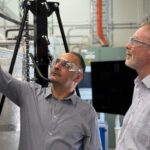C282/09
Researchers at Curtin University of Technology have developed equipment that will allow oil and gas drillers to accurately model the environments encountered when drilling at great depths.
The equipment — a True Triaxial Stress Cell (TTSC) — is the first of its kind in Australia and is the work of Dr Vamegh Rasouli of Curtin’s Department of Petroleum Engineering.
Now operational, this technology should improve access to oil and gas located deep beneath the Earth’s surface and in highly anisotropically stressed environments.
These are environments that involve both horizontal and vertical stresses which are due to tectonic plates moving apart.
Curtin’s Head of Petroleum Engineering, Professor Brian Evans, said the new equipment would potentially allow petroleum companies to drill deeper.
“The potential use of this equipment is quite significant,” he said.
“There are deep gas deposits not far from Perth that are currently seen as being too deep to affordably access.
“However, using the equipment developed at Curtin, drillers would be in a better position to model drilling operations and, therefore, more able to drill deeper more economically and access these deposits.”
Dr Rasouli said the technology would allow the accurate simulation of the conditions encountered when drilling kilometres into the Earth.
He said this was achieved by applying large amounts of physical stresses from three different directions independently — one vertical and two horizontal. This allowed a large range of drilling scenarios to be simulated by changing the formation and fluid properties and the pressure applied to the model.
“We can inject fluid or gas into a drilled borehole in the centre of the sample,” Dr Rasouli said.
“It can also be saturated with any fluid to accurately model hydraulic fracturing.
“Similarly, the production of sand can be modelled by increasing pore pressure within an unconsolidated sample of sand.
“We can monitor the induced fracturing and rock failure, and fracture geometry in the sample rocks using seismic transducers.
“This allows us to accurately model the environments encountered when drilling for petroleum at great depths.
“Using this technology we will be able to observe changes in formation properties which will account for various geological situations, drilling fluid and formation pore pressure.
“This will, we hope, assist WA companies in accessing the Perth region’s gas deposits, ensuring our energy security and increased gas exports.”
Contact: Professor Brian Evans; Head, Department of Petroleum Engineering; Curtin; 9266 7092; B.Evans@curtin.edu.au Dr Vamegh Rasouli; Senior Lecturer, Department of Petroleum Engineering; Curtin; 9266 1341; V.Rasouli@curtin.edu.au OR Shaun Ratcliff; Public Relations Coordinator; Curtin; 08 9266 9085; 0401 103 755; s.ratcliff@curtin.edu.au


